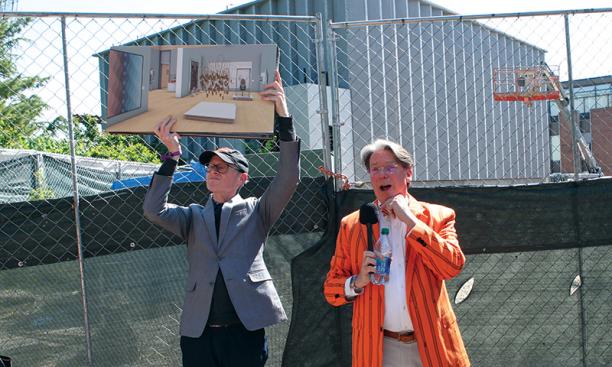
Reunions is about seeing old friends … and seeing how old friends have gotten. Come on, you know it’s true. But perhaps the biggest surprise for attendees this year was how much the campus itself has changed.
“I don’t even recognize the place” was a common refrain, and it’s understandable if you were celebrating your 15th reunion or older. Since 2008, more than 20 new building projects have been completed.
Then there’s the ongoing construction. This includes major projects such as the new Art Museum, the Dillon Gym wellness and fitness center, Hobson College, the Environmental Studies and School of Engineering and Applied Science (ES and SEAS) complex, and the Meadows Neighborhood just across Lake Carnegie.
Even President Christopher Eisgruber ’83, during his annual address to alumni, couldn’t resist a dig at all the digging. “There was a lot more community and less distancing, but also more fences, as you’ve seen on campus. So COVID wasn’t keeping us apart; occasionally, fences do,” he said while speaking in Richardson Auditorium. “And you may have run into one or two of those as you were taking what used to be your favorite path across campus and suddenly found that it was obstructed by a construction site.”
The University has almost always been growing, starting with Nassau Hall opening for business in 1756. It collected hundreds of acres of land following the Civil War and into the early 20th century, giving it “ample room for growth … for many years to come,” trustee Moses Taylor Pyne 1877 said, apparently unconcerned that future alumni might be annoyed by detours. But the current changes may be more dramatic than ever before since a few of them run through the heart of campus and the others (ES and SEAS complex and the Meadows Neighborhood) are significant expansions.
Based on my unscientific survey at Reunions, alumni are most thrown by the Art Museum. Scheduled to open in the fall of 2024, the building is taking shape and looks every bit of its planned 124,000 square feet. The location, between Elm Drive, Prospect House, and McCosh Walk, was also concerning to many.
As one alumnus asked University Architect Ron McCoy *80 during an organized conversation Friday: “How do you justify this huge footprint … on campus that changes an open space … to be more like Manhattan, with buildings right next to each other that formerly had open spaces in front of them? How do you justify that to old alumni like me?” To which McCoy responded: “The building embraces the landscape around itself and brings that landscape into the room.” Many were not convinced.
Of course, there’s a reason for this disruption: more students. With the new housing, first-year enrollment increased this past academic year to 1,500 from 1,345, the first step in a four-year expansion of the undergraduate student body to about 5,700 students from 5,200. Or as Eisgruber said, they can now “say yes to more students.”
Current students, though, just want some peace and quiet. Inconvenience and especially noise have been a constant issue for those living near construction sites.
Gavin LaPlace ’23 spoke at Class Day about the challenges his class faced the past four years — such as COVID and those ubiquitous electric scooters — and joked, “But at least the University gave us complementary 7 a.m. alarms this year to make up for all that.”
While students don’t like the construction and alumni don’t care for the expansion, we can all take comfort knowing there will be more students with access to a Princeton education, and that they will likely grow up to become alumni who also don’t like to be inconvenienced.
